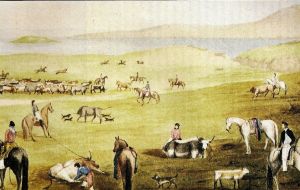MercoPress. South Atlantic News Agency
“Gauchos in Malvinas”, part of Falklands' history is a collection of watercolors
 Marcelo Beccaceci, an expert in gaucho culture in Patagonia, is the author of the book and who collected the watercolors.
Marcelo Beccaceci, an expert in gaucho culture in Patagonia, is the author of the book and who collected the watercolors.  Beccaceci admitted his surprise when at the Stanley Museum he came across one of those aquarelles which showed the gauchos in a typical display of their skills
Beccaceci admitted his surprise when at the Stanley Museum he came across one of those aquarelles which showed the gauchos in a typical display of their skills “Gauchos in Malvinas” is the title of the book launched at the recent Buenos Aires Book show which is mainly a collection of water colors by William Dale, painted in 1852 when he spent time in the Falkland Islands. He was the son of John Pownall Dale, at the time General Manager of the Falkland Islands Company, and his paintings are considered a unique and only testimony of the gauchos in the Falklands.
Marcelo Beccaceci, is the author of the book and who collected the watercolors. An expert in gaucho culture in Patagonia, he admitted his surprise when visiting the Stanley Museum in Falklands and coming across one of those aquarelles which showed the gauchos in a typical display of their skills with horses and cattle, and their clothing and traditions such as barbecues.
In his return to Buenos Aires Beccaceci contacted an editor of English books and mentioned the aquarelle. Although at first the editor said he was aware of the full collection of the watercolors, he also pointed out he was not authorized to reveal addresses. However not long after Beccaceci, obsessed with gauchos in the Falklands, came across the secretive Lough brothers who had the complete collection of William Dale's watercolors.
After some convincing Tim and Gavin Lough showed Beccaceci the aquarelles and allowed him to photograph them. This was the starting point for the book on Gauchos in Malvinas, and together with information from the Argentine National History Archives, Beccaceci was able to make up the history of the gauchos who were sent to the Islands after the cattle allegedly left behind by the Spaniards when they abandoned the region in 1811. In 1824 the first expedition of gauchos, 26 men and five horses arrived financed by the French business brothers Vernet. But the first attempt apparently was a failure and the surviving gauchos had to wait a full year in the Islands.
Surviving was tough, the weather, the loneliness, the scarce resources and on top of that the Vernet brothers exploitation. They paid the gauchos in IOUs, and they had to purchase all their tools for cattle rounding up from a store the Vernet had opened in Port Louis. The gauchos only counted with meat and a promise of a return trip to Argentina, which rarely was honored. According to Beccaceci the whole situation blew up in 1833, when Antonio Rivero, the renegade killed Vernet employees and went on the loose.
“For years there have been revisionist attempts regarding this episode as an act of patriotism, but the fact is Rivero never flew an Argentine flag” underlines Beccaceci. On the contrary his criminal actions only triggered a quick reaction from the British, who then took over the Islands permanently.
“What matters is that the gauchos remained in the Islands working next to the English, and this is clearly evident in the watercolors, and it is part of the Argentine history that has been hidden, but I intend to recover the identity of those gauchos buried in the Islands”, explained Beccaceci.
Speaking with La Nacion, the Argentine author confesses to be surprised by so many geographical names that date back to the gauchos time as well as Spanish terms to describe horse coat colors and related terminology referred to saddles, saddle straps, reins, etc.
Finally Beccaceci mentions that while in the Falklands he came across Taff Davies who commented that “Argentines have converted Gaucho Rivero in a kind of Robin Hood, but the fact is that he was ruthless, despicable character”.




Top Comments
Disclaimer & comment rules-

-

-

Read all commentsLieut. Smith's appointment as Resident at the Falklands was unconnected to the Rivero murders. Came as a nice surprise to him :-)
May 17th, 2018 - 11:20 am +3The legend artificially created by Argentine fascism (I mean by Peronism) transformed a criminal into a hero. Typical attitude of the fascists who need to modify history so that the present, daughter of history, shows them that their positions are always correct.
May 18th, 2018 - 12:28 pm +2Anyway, the really interesting issue in this history is the “return”, the referral, of Gaucho Rivero to Montevideo by a British judge.
“Argentines have converted Gaucho Rivero in a kind of Robin Hood, but the fact is that he was ruthless, despicable character”.
May 17th, 2018 - 09:13 pm +1This should surprise no one. The country has enjoyed and continues to enjoy a substantial surplus of ruthless and despicable characters.
Some time ago the Kirchner government stole the artwork belonging to one of its citizens, converting it into an image which purported to portray the despicable Rivero, to use on its new 50 peso currency. I don't think the photographer-artist ever received compensation from the more contemporary despicable thieves, those of the Kirchner government, who appropriated the intellectual property. Some of the story is here, in the vernacular:
https://www.lanacion.com.ar/1857422-un-plagio-de-50-pesos-el-misterio-del-gaucho-rivero-en-el-billete
From that news note came the summary for the character of Argentina:
“...y lo incorrecto es incorrecto aunque lo hagan todos”. (what is wrong is wrong even though everyone does it)
Fancy the UK government producing paper money with the likeness of murderers Amelia Dyer or Harold Shipman.
Commenting for this story is now closed.
If you have a Facebook account, become a fan and comment on our Facebook Page!